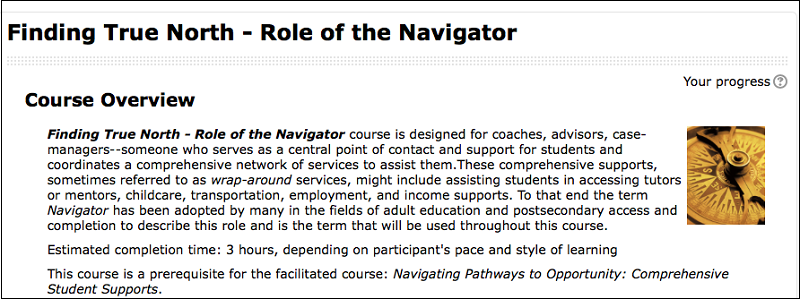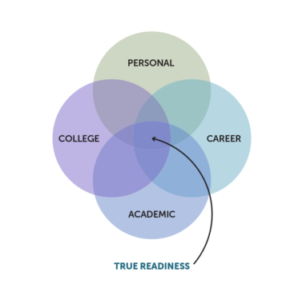- MN ABE Connect
- Archive
- Using PLCs to Develop Navigation Practices with ABE Teachers
 June 15, 2019
June 15, 2019
Using PLCs to Develop Navigation Practices with ABE Teachers
Stephanie Sommers, ACES Coordinator Heather Turngren, Minneapolis Regional Transtitions CoordinatorOrganizing a training, or a series of trainings, from the bottom up is a big job. You have to identify your audience, your desired outcomes, and your learning objectives. You have to design the content and the learning materials. And before all of that, you have to learn as much as you can about the topic.
When I was first approached about designing a professional learning community (PLC) training around navigation practices, I was only passingly familiar with the term “Navigator.” My quest to learn more started where most 21st century quests begin, with the Internet. I also reached out to others doing similar work and met with colleagues from the Minnesota Literacy Council to learn about their volunteer navigator training. Online I found a course through World Education called Finding True North – Role of the Navigator (https://elearning-worlded.coursestorm.com/course/finding-true-north-role-of-the-navigator).

The course was originally developed by the National College Transition Network (NCTN), and it was free and self-paced. The course follows a NCTN framework for defining college and career readiness. It looks at readiness as four overlapping areas: personal readiness, career readiness, academic readiness, and college knowledge. In the center of the four circles is what NCTN calls “true readiness.” With this framework, I found a structure for the PLC training.
The next step was to enlist the help of my ABE collaborator, Heather Turngren. Heather and I have worked on many projects together, and we are both ACES trainers. We wanted the PLC to be similar to the ACES PLCs that were designed to introduce teachers to the six ACES categories.
 As such, we divided the content into three 3-hour meetings. Meeting 1 focused on learning about the four areas of readiness and discussing why ABE students benefit from navigation services. We also looked at the Self-Management category of the TIF (Transitions Integration Framework) as a way to develop personal readiness. Meeting 2 focused on the Learning Strategies category as a way to develop Academic Readiness, and the focus of meeting 3 was on using the Developing a Future Pathway category to develop career readiness and Navigating Systems for college readiness.
As such, we divided the content into three 3-hour meetings. Meeting 1 focused on learning about the four areas of readiness and discussing why ABE students benefit from navigation services. We also looked at the Self-Management category of the TIF (Transitions Integration Framework) as a way to develop personal readiness. Meeting 2 focused on the Learning Strategies category as a way to develop Academic Readiness, and the focus of meeting 3 was on using the Developing a Future Pathway category to develop career readiness and Navigating Systems for college readiness.
Between the meetings, the participants tried out lessons and routines with their students that focused on each category and skill area. The participants also completed the online course. There was time at each meeting to discuss the outside tasks. Participants shared ideas about lessons and routines to try in the classroom, and they shared out what went well and what could be improved after implementation.
According to the PLC evaluations, one of the greatest benefits of a PLC is the collaborative learning process among teachers. In answer to the question, “What was the most helpful aspect of this PLC?” participants wrote: “learning from other ABE instructors,” “sharing ideas with colleagues,” and “gathering resources from other teachers.”
Another theme that emerged from the PLC was the desire to continue the collaboration and sharing after the final meeting. The participants talked about wanting to meet again in three to six months to share their work and continue the conversations. We hope to make on-going collaboration easier by launching a new group on Schoology for sharing ideas related to ACES and transitions skills. Look for the ACES (Academic, Career, & Employability Skills) Networking Group to be open for new members starting in August.
This PLC was funded with Transitions Funds from the East Metro region under the direction of Regional Transitions Coordinator Russ Frankel. It included ABE teachers from five ABE programs in the East Metro Transitions Region. The managers in this region were interested in exploring how teachers could learn to embed certain navigation practices into their ABE classrooms, and whether these practices could increase student retention and lead to more students achieving their education and career goals. Heather and I wanted to know if helping students to do things like ask better questions, seek information more independently, and explore career options could make them more self-sufficient, and, thereby, lessen the need for a designated Navigator.
Our initial PLC finished on May 17, and we think it’s safe to say that the answer to all of these questions is yes. If you are interested in finding out more about using PLCs for professional development and developing navigation practices with ABE teachers, plan to join us at a panel discussion at the 2019 ABE Summer Institute. The session is scheduled for Thursday morning at 9:30. “Navigate” your way to St. Cloud to learn more.

Newsletter Signup
Get MN ABE Connect—the official source for ABE events, activities, and resources!
Sign UpArticle Categories
- ABE Foundations/Staff Onboarding
- ACES/Transitions
- Adult Career Pathways
- Assessment
- CCR Standards
- Citizenship
- COVID-19
- Cultural Competency
- Digital Literacy/Northstar
- Disabilities
- Distance Learning/Education
- ELA
- Equity/Inclusion
- ESL
- HSE/Adult Diploma
- Listening
- Math/Numeracy
- Mental Health
- Minnesota ABE
- One-Room Schoolhouse/Multilevel
- Professional Development
- Program Management
- Reading
- Remote Instruction
- Science
- Social Studies
- Speaking/Conversation
- Support Services
- Teaching Strategies
- Technology
- Uncategorized
- Volunteers/Tutors
- Writing